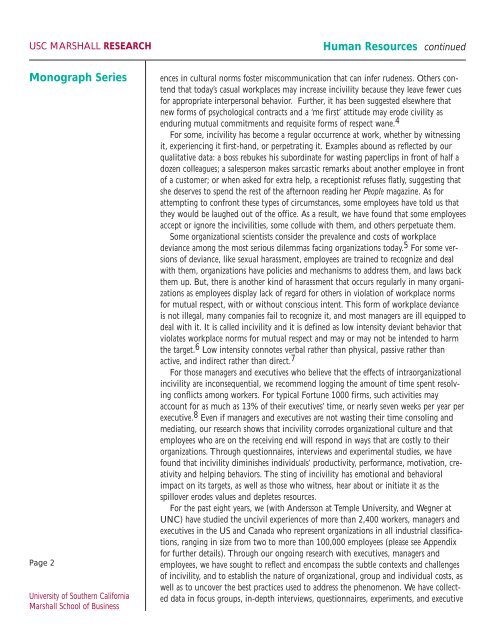On the Nature, Consequences and Remedies of Workplace Incivility
On the Nature, Consequences and Remedies of Workplace Incivility
On the Nature, Consequences and Remedies of Workplace Incivility
You also want an ePaper? Increase the reach of your titles
YUMPU automatically turns print PDFs into web optimized ePapers that Google loves.
USC MARSHALL RESEARCH Human Resources continued<br />
Monograph Series<br />
Page 2<br />
University <strong>of</strong> Sou<strong>the</strong>rn California<br />
Marshall School <strong>of</strong> Business<br />
ences in cultural norms foster miscommunication that can infer rudeness. O<strong>the</strong>rs contend<br />
that today’s casual workplaces may increase incivility because <strong>the</strong>y leave fewer cues<br />
for appropriate interpersonal behavior. Fur<strong>the</strong>r, it has been suggested elsewhere that<br />
new forms <strong>of</strong> psychological contracts <strong>and</strong> a ‘me first’ attitude may erode civility as<br />
enduring mutual commitments <strong>and</strong> requisite forms <strong>of</strong> respect wane. 4<br />
For some, incivility has become a regular occurrence at work, whe<strong>the</strong>r by witnessing<br />
it, experiencing it first-h<strong>and</strong>, or perpetrating it. Examples abound as reflected by our<br />
qualitative data: a boss rebukes his subordinate for wasting paperclips in front <strong>of</strong> half a<br />
dozen colleagues; a salesperson makes sarcastic remarks about ano<strong>the</strong>r employee in front<br />
<strong>of</strong> a customer; or when asked for extra help, a receptionist refuses flatly, suggesting that<br />
she deserves to spend <strong>the</strong> rest <strong>of</strong> <strong>the</strong> afternoon reading her People magazine. As for<br />
attempting to confront <strong>the</strong>se types <strong>of</strong> circumstances, some employees have told us that<br />
<strong>the</strong>y would be laughed out <strong>of</strong> <strong>the</strong> <strong>of</strong>fice. As a result, we have found that some employees<br />
accept or ignore <strong>the</strong> incivilities, some collude with <strong>the</strong>m, <strong>and</strong> o<strong>the</strong>rs perpetuate <strong>the</strong>m.<br />
Some organizational scientists consider <strong>the</strong> prevalence <strong>and</strong> costs <strong>of</strong> workplace<br />
deviance among <strong>the</strong> most serious dilemmas facing organizations today. 5 For some versions<br />
<strong>of</strong> deviance, like sexual harassment, employees are trained to recognize <strong>and</strong> deal<br />
with <strong>the</strong>m, organizations have policies <strong>and</strong> mechanisms to address <strong>the</strong>m, <strong>and</strong> laws back<br />
<strong>the</strong>m up. But, <strong>the</strong>re is ano<strong>the</strong>r kind <strong>of</strong> harassment that occurs regularly in many organizations<br />
as employees display lack <strong>of</strong> regard for o<strong>the</strong>rs in violation <strong>of</strong> workplace norms<br />
for mutual respect, with or without conscious intent. This form <strong>of</strong> workplace deviance<br />
is not illegal, many companies fail to recognize it, <strong>and</strong> most managers are ill equipped to<br />
deal with it. It is called incivility <strong>and</strong> it is defined as low intensity deviant behavior that<br />
violates workplace norms for mutual respect <strong>and</strong> may or may not be intended to harm<br />
<strong>the</strong> target. 6 Low intensity connotes verbal ra<strong>the</strong>r than physical, passive ra<strong>the</strong>r than<br />
active, <strong>and</strong> indirect ra<strong>the</strong>r than direct. 7<br />
For those managers <strong>and</strong> executives who believe that <strong>the</strong> effects <strong>of</strong> intraorganizational<br />
incivility are inconsequential, we recommend logging <strong>the</strong> amount <strong>of</strong> time spent resolving<br />
conflicts among workers. For typical Fortune 1000 firms, such activities may<br />
account for as much as 13% <strong>of</strong> <strong>the</strong>ir executives’ time, or nearly seven weeks per year per<br />
executive. 8 Even if managers <strong>and</strong> executives are not wasting <strong>the</strong>ir time consoling <strong>and</strong><br />
mediating, our research shows that incivility corrodes organizational culture <strong>and</strong> that<br />
employees who are on <strong>the</strong> receiving end will respond in ways that are costly to <strong>the</strong>ir<br />
organizations. Through questionnaires, interviews <strong>and</strong> experimental studies, we have<br />
found that incivility diminishes individuals’ productivity, performance, motivation, creativity<br />
<strong>and</strong> helping behaviors. The sting <strong>of</strong> incivility has emotional <strong>and</strong> behavioral<br />
impact on its targets, as well as those who witness, hear about or initiate it as <strong>the</strong><br />
spillover erodes values <strong>and</strong> depletes resources.<br />
For <strong>the</strong> past eight years, we (with Andersson at Temple University, <strong>and</strong> Wegner at<br />
UNC) have studied <strong>the</strong> uncivil experiences <strong>of</strong> more than 2,400 workers, managers <strong>and</strong><br />
executives in <strong>the</strong> US <strong>and</strong> Canada who represent organizations in all industrial classifications,<br />
ranging in size from two to more than 100,000 employees (please see Appendix<br />
for fur<strong>the</strong>r details). Through our ongoing research with executives, managers <strong>and</strong><br />
employees, we have sought to reflect <strong>and</strong> encompass <strong>the</strong> subtle contexts <strong>and</strong> challenges<br />
<strong>of</strong> incivility, <strong>and</strong> to establish <strong>the</strong> nature <strong>of</strong> organizational, group <strong>and</strong> individual costs, as<br />
well as to uncover <strong>the</strong> best practices used to address <strong>the</strong> phenomenon. We have collected<br />
data in focus groups, in-depth interviews, questionnaires, experiments, <strong>and</strong> executive


